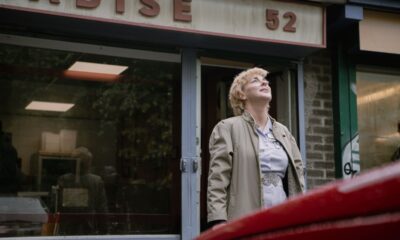Lifestyle
Pension Campaigner Urges Government to Retain Triple Lock

The future of the UK’s state pension system is under scrutiny as the government faces mounting pressure regarding the triple lock mechanism. This system guarantees an annual increase in the state pension based on the highest of inflation, average earnings growth, or 2.5 percent. Currently, the government has pledged to maintain the triple lock until the end of this parliamentary term, but its longevity beyond that point remains uncertain. Some experts predict that by 2030, the escalating costs may necessitate its removal.
Dennis Reed, director of the campaign group Silver Voices, argues that the triple lock should be preserved until the state pension reaches a more livable amount. He emphasizes that the current full new state pension of £230.25 per week, which translates to approximately £11,973 annually, represents just a third of median earnings. He believes it is essential for the pension to rise to around £340 per week, or a similar “respectable figure,” before any discussions about altering or abolishing the triple lock can take place.
Reed’s organization has previously been active in advocating for pensioners’ rights, notably in opposition to the Labour Party’s decision to cut the winter fuel allowance for many seniors last year. Now, he is focused on maintaining the current state pension uprating mechanism, which he views as crucial for the well-being of older citizens.
According to a recent report from the Office for Budget Responsibility (OBR), the annual cost of the triple lock policy is expected to reach £15.5 billion by 2030. The OBR noted that the cost of the state pension has steadily increased over the past 80 years, rising from around 2 percent of the UK’s economy to 5 percent today. Reed critiques the OBR’s long-term projections, arguing that they fail to account for demographic changes and increased life expectancy.
He explains, “That 80-year timeframe relates to the start of the welfare state after the war. We all know people didn’t used to live quite often beyond their 60s. In those days, there were far fewer older people than there are today. So that is a ludicrous figure to use.”
Debate continues regarding how to fund the triple lock if it remains in place. Some, including the Institute for Fiscal Studies (IFS), have suggested that raising the state pension age may be necessary. Reed counters this notion, stating, “The argument is much weaker than it was ten years ago.” He cites stabilizing life expectancy rates, which have recently shown a decrease. For instance, life expectancy in the UK from 2020 to 2022 was 78.6 years for males and 82.6 years for females, reflecting a decline from previous years.
As discussions about funding the pension intensify, Reed believes the solution lies in addressing wealth inequality rather than imposing tax increases or cutting social spending. He highlights, “Everybody accepts that our society is very unequal. People living on the state pension look around, and there is egregious wealth everywhere.”
Reed warns against the narrative of intergenerational conflict perpetuated by some policymakers and think tanks, which frames older people as hoarding wealth. He argues, “Many or most older people are not going on cruises every other month, but these examples are often held up as a reason why the level of the state pension should come under scrutiny. It’s a fake battle being used to stoke pressure.”
Moreover, Reed points out that younger generations should not view cuts to the state pension as beneficial for their future. He asserts, “Cutting the state pension now is not going to benefit them. In fact, they themselves will need the state pension in the future more than we do.”
While some advocate for personal responsibility in retirement planning, Reed maintains that the state pension serves as a critical safety net. He explains that individuals pay into the National Insurance system during their working lives, granting them entitlement to a pension that provides security in retirement.
He concludes, “Pension pots can collapse, as we know. Everything depends on the stock market. To deny that people need a safety net of a good state pension seems very short-sighted indeed.” As the government evaluates the future of the triple lock, the conversation is likely to continue, with advocates like Reed pushing for a system that ensures dignity and security for all citizens in their later years.
-

 Entertainment2 months ago
Entertainment2 months agoAnn Ming Reflects on ITV’s ‘I Fought the Law’ Drama
-

 Entertainment3 months ago
Entertainment3 months agoKate Garraway Sells £2 Million Home Amid Financial Struggles
-

 Health2 months ago
Health2 months agoKatie Price Faces New Health Concerns After Cancer Symptoms Resurface
-

 Entertainment2 months ago
Entertainment2 months agoCoronation Street’s Carl Webster Faces Trouble with New Affairs
-

 Entertainment2 months ago
Entertainment2 months agoWhere is Tinder Swindler Simon Leviev? Latest Updates Revealed
-

 Entertainment3 months ago
Entertainment3 months agoKim Cattrall Posts Cryptic Message After HBO’s Sequel Cancellation
-

 Entertainment2 months ago
Entertainment2 months agoOlivia Attwood Opens Up About Fallout with Former Best Friend
-

 Entertainment2 months ago
Entertainment2 months agoMasterChef Faces Turmoil as Tom Kerridge Withdraws from Hosting Role
-

 Entertainment3 months ago
Entertainment3 months agoMarkiplier Addresses AI Controversy During Livestream Response
-

 Entertainment4 months ago
Entertainment4 months agoSpeculation Surrounds Home and Away as Cast Departures Mount
-

 World2 months ago
World2 months agoCole Palmer’s Mysterious Message to Kobbie Mainoo Sparks Speculation
-

 Entertainment2 months ago
Entertainment2 months agoITV’s I Fought the Law: Unraveling the True Story Behind the Drama





















